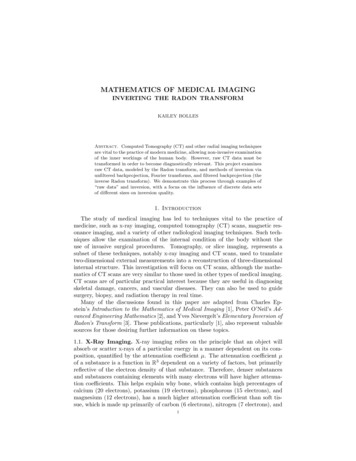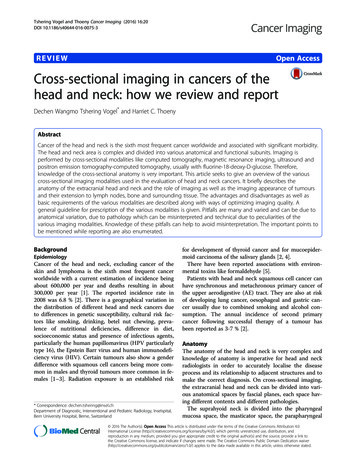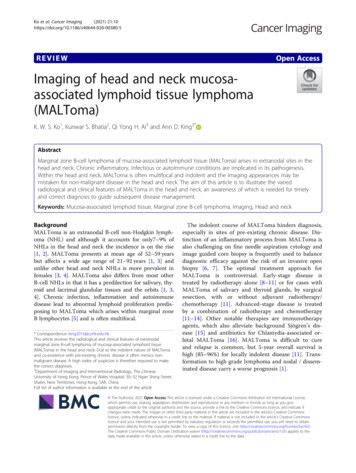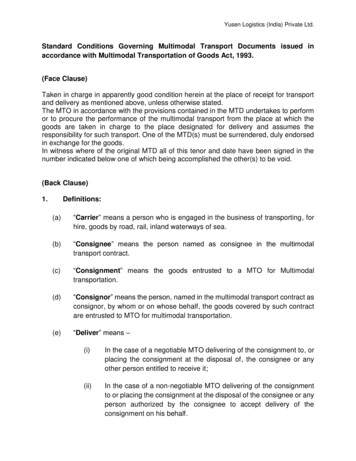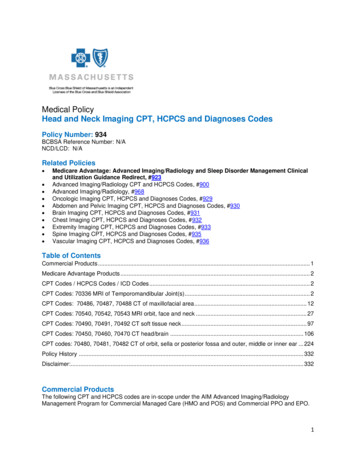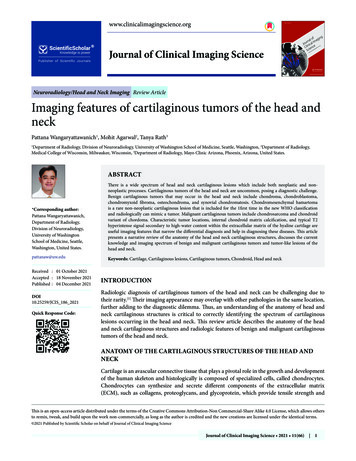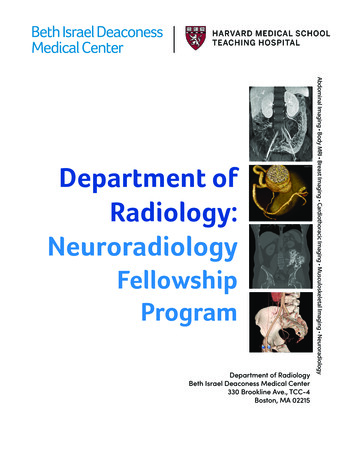
Transcription
Advanced HNSCC requires multimodalimaging for appropriate, multidisciplinarytreatment planning and follow up.Irena Orlov. Industrial feel 5673. Digital on canvas, 40" 60".Multimodal Imaging of Head and Neck Squamous Cell CarcinomaKenneth L. Gage, MD, PhD, Kerry Thomas, MD, Daniel Jeong, MD, Dexter G. Stallworth, MD,and John A. Arrington, MDBackground: The role of imaging in the staging, treatment planning, and ongoing surveillance of patientswith head and neck squamous cell carcinoma (HNSCC) continues to evolve. Changes in patient demographics,treatment paradigms, and technology present opportunities and challenges for the management of HNSCC.Methods: The general indications and usage of standard and multimodal cross-sectional imaging in the evaluation and management of HNSCC are reviewed, with an emphasis on incorporating them into treatment pathways. Emerging imaging technologies and methods with a potential near-term impact on HNSCC are discussed.Results: In general, the complex, multidisciplinary approach to the treatment of advanced HNSCC requiresmultimodal imaging for adequate treatment planning and follow up. Early-stage disease can often be managed with clinical and endoscopic examinations and a single, cross-sectional imaging modality (eg, computedtomography, magnetic resonance imaging).Conclusions: Although generalized treatment pathways and guidelines do exist, the literature is rapidlyadvancing and new radiotracers and evaluation methods are expected to alter both imaging and treatmentrecommendations in the years to come.BackgroundIn the United States, head and neck cancers are expected to account for 3.7% (63,030 new cases) of all cancers diagnosed in 2017.1 In that same year, an estimated13,360 Americans will die as a result of tumors involving the oral cavity, pharynx, and larynx.1 The worldwide incidence of new cases of head and neck cancersFrom the Diagnostic Imaging and Interventional RadiologyProgram (KLG, KT, DJ, DGS, JAA), H. Lee Moffitt Cancer Center& Research Institute, and the Departments of Oncologic Sciences(JAA) and Radiology (JAA), University of South Florida College ofMedicine, Tampa, Florida.Address correspondence to John A. Arrington, MD, MoffittCancer Center, 12902 Magnolia Drive, WCB-RAD MD/OPI,Tampa, FL 33612. E-mail: John.Arrington@Moffitt.orgSubmitted November 10, 2016; accepted March 28, 2017.No significant relationships exist between the authors and thecompanies/organizations whose products or services may bereferenced in this article.172 Cancer Controlis estimated to be greater by an order of magnitude,with 686,000 new cases diagnosed and 375,000 relateddeaths.2 Head and neck cancers encompass a broadrange of tumor histologies and locations. However,more than 90% of head and neck cancers are squamous cell carcinomas, arising from the upper aerodigestive tract and frequently involving the oral cavity,oropharynx, hypopharynx, and larynx.2 Although theoverall rate of new cases of oropharyngeal cancer inthe United States has been stable or decreasing, caseslinked to human papillomavirus (HPV) continue torise, altering the demographics and presentation ofnew cases of head and neck squamous cell carcinoma(HNSCC).3Because of its low contribution to the overall cancer incidence in the United States, the true impact ofHNSCC on public health may be under-represented.1No widely accepted screening test exists for HNSCC,April 2017, Vol. 24, No. 2
and many patients present with advanced-stage disease, requiring disfiguring surgery, chemoradiotherapy, or both. Both timely diagnosis and accurate stagingof HNSCC are critical to avoid under- or overtreatmentand to minimize mortality and morbidity. Thus, the objective of this review is to summarize the role of imaging in the management of HNSCC throughout the continuum of care while also providing clinical exampleshighlighting the strengths and weaknesses of eachimaging modality (magnetic resonance imaging [MRI],contrast-enhanced computed tomography [CT], andpositron emission tomography [PET]/CT).Role of ImagingSince the introduction of CT and MRI, the role of imaging in HNSCC has grown. The widespread applicationof fludeoxyglucose F 18 (18F-FDG) positron emissiontomography (PET) in the late 1990s added a functionalmetabolic component to imaging, with the subsequentfusion of functional (PET) and anatomical (CT) imaging in the combined modality of PET/CT resulting infurther improvements in disease management.4 Continued technological progress and the broadeningapplications further increase the role of diagnosticimaging in the evaluation and management of HNSCC. PET/CT, contrast-enhanced CT, and MRI havewell-defined strengths and weaknesses and, therefore,play complementary roles in the evaluation and treatment planning of HNSCC. However, no single imagingmodality can accurately diagnose, stage, and providelong-term surveillance of HNSCC.Initial StagingAccurate initial staging is critical to the establishmentof prognosis, treatment selection, and the management of HNSCC. Guidelines issued by the AmericanJoint Commission on Cancer represent the standardfor HNSCC staging and require detection and precisedelineation of the patient’s primary tumor (T), cervical nodal involvement (N), and distant metastases(M) for classifying patients, a process known as TNMstaging.5 These guidelines provide separate stagingcriteria based on the mucosal site of origin, separating patients into those with cancers of the lip and oralcavity, pharynx, and larynx.5 The resulting prognosticstage groupings range from stages I to IV and also include substages.5In general, diagnostic imaging complements theclinical evaluation of the primary tumor and regionalcervical lymph nodes and can be used to detect metastases and second primary tumors in patients withHNSCC. Following an initial clinical examination andendoscopy of the upper aerodigestive tract with biopsy, staging is refined with diagnostic imaging and finalized with the pathological evaluation of cervical lymphnodes from nodal dissection, if performed.April 2017, Vol. 24, No. 2Primary SiteThe extent of mucosal involvement by the primary tumor is best documented through clinical and endoscopic examinations, whereas imaging is obtained to evaluate submucosal and deep, soft-tissue extension as wellas osseous, cartilaginous, or skull-base involvement.The location of the primary site of disease can influence the selection of modalities for initial imagingassessment. For example, MRI is often the preferredimaging modality for evaluating the oral cavity, especially the anterior tongue, retromolar trigone, andthe floor of the mouth, in which dental hardware andbeam-hardening artifact can limit the usefulness ofCT (Fig 1).6,7 MRI provides superior soft-tissue contrastand allows the detection of suspicious changes in bonemarrow, aiding in the evaluation of the adjacent mandible and other osseous structures when tumor invasion is suspected. MRI is considered the best imagingmodality for assessing perineural tumor spread, intracranial and orbital extension (Fig 2), nasopharyngealcarcinoma, and marrow involvement.However, the superior, soft-tissue contrast providedby MRI of the head and neck is not without its own limitations. The intense inflammatory response surrounding some lesions highlighted with contrast-enhancedMRI can lead to difficulties in determining the true extent of disease, thus complicating treatment approachesand radiation fields (Fig 3). In some cases, the true lesionburden is better delineated with functional techniquessuch as PET/CT. In addition, the relative scarcity of excitable protons in the osseous matrix results in minimalsignal from cortical bone, which may limit the detectionABCDFig 1A–D. — A man aged 63 years with an infiltrating, destructive massinvolving the right mandible from right retromolar trigone squamouscell carcinoma. (A) Axial, contrast-enhanced CT reveals the limited lesion visibility from beam-hardening artifact on CT, even from primarilyleft-sided dental hardware. (C) Coronal imaging allow improved visualization of the mandibular destruction; however, contrast-enhanced,T1-weighted, fat-suppressed imaging (B and D) provides better representation of the true extent of soft-tissue involvement in this case.CT computed tomography.Cancer Control 173
and accurate characterization of osseous destruction onMRI (Fig 4). In these cases, diagnostic CT is often considered the best imaging modality for lesion assessment.Locoregional and Nodal DiseaseThe most important factor that affects prognosis is cervical nodal status, and an accurate assessment is critical to the treatment plan and choice of therapy. PatientsABFig 2A–B. — A man aged 63 years with aggressive squamous cell carcinoma involving the skull base. (A) Sagittal, contrast-enhanced computedtomography reveals a destructive, centrally hypoenhancing mass at theskull base with unclear involvement of the intracranial structures. (B) Contrast-enhanced, T1-weighted, fat-suppressed imaging obtained at a similarorientation demonstrates dural enhancement, increasing clinical suspicionfor intracranial tumor growth. The carotid artery was also circumferentiallyinvolved and narrowed (not shown), which is a poor prognostic sign.ACwith cervical nodal metastasis, distant metastasis, orboth types of metastases have worse prognoses anddecreased 5-year survival rates when compared withthose without metastatic disease.1 The importance ofnodal status for overall prognosis and managementis such that debate remains as to when elective neckdissections or irradiation should be performed, witha 20% or greater risk of occult, microscopic nodal disease often used as a threshold for prophylactic treatment.8 Imaging detection (or exclusion) of clinically occult nodal metastasis, distant metastasis, or both typesof metastases may alter the treatment plan, thus reducing rates of unnecessary surgery and therapy as well asassociated morbidity and cost.Diagnostic imaging adds to the clinical evaluationof cervical nodal involvement by detecting clinically occult nodal metastases and identifying morphologicalfeatures of clinical importance (Fig 5), such as the presence of extracapsular nodal extension, vascular encaseABDFig 4A–B. — A man aged 63 years with aggressive squamous cell carcinomainvolving the skull base (same patient as Fig 2). (A) Sagittal, contrast-enhancedCT imaging reconstructed with a bone algorithm reveals sclerosis of the skullbase (red arrow) and cortical destruction in the more posterior temporal bone(red arrowheads). (B) Contrast-enhanced, T1-weighted, fat-suppressed MRIobtained in a similar plane also demonstrates significant marrow enhancement along the area of sclerosis seen on CT; however, the osseous destructionis not well appreciated on MRI when compared with CT (red arrow).CT computed tomography, MRI magnetic resonance imaging.AFig 3A–D. — (A) Contrast-enhanced, T1-weighted, fat-suppressed and(B) T2-weighted, fat-suppressed axial imaging of a woman aged 55 yearswith aggressive squamous cell carcinoma involving the right pterygoidsand their osseous structures. (A) T1-weighted imaging reveals the presence of a hypoenhancing, possibly necrotic component (red arrow), butthe overall degree of enhancement obscures the exact extent of disease. (B) T2-weighted, fat-suppressed imaging delineates the lesion margins (red arrowheads), closely correlating with the findings on (C) fludeoxyglucose F 18 PET/CT. (D) Magnetic resonance imaging poorly demarcatesthe extent of bone destruction (yellow arrow), which is best illustrated onthe CT component of PET/CT imaging (C and D).CT computed tomography, PET positron emission tomography.174 Cancer ControlBBFig 5A–B. — (A) Axial, contrast-enhanced CT and (B) fludeoxyglucose F 18PET/CT demonstrating an ill-defined mass (red arrows) obliterating the fatplanes deep into the right sternocleidomastoid muscle in a man aged 52 yearswith human papillomavirus-positive squamous cell carcinoma. PET/CT imaging suggests low-level, possibly nonspecific activity; however, the absenceof clear fat planes and the infiltrative appearance of the lesion on contrastenhanced CT suggest extracapsular nodal disease, a poor prognostic factor.CT computed tomography, PET positron emission tomography.April 2017, Vol. 24, No. 2
ment, and “matted” lymphadenopathy (loss of the fatplane between 3 adjacent lymph nodes with extracapsular tissue).9,10 In general, contrast-enhanced CT andMRI are superior for detecting nodal anatomic featuresand provide an excellent anatomical road map for surgical planning; PET/CT demonstrates excellent overallsensitivity for the presence of nodal metastatic disease.The detection of small, nonclustering nodal metastases can be challenging when using anatomical imaging approaches such as CT or MRI. Criteria have beenestablished for the assessment of cervical lymph nodesusing both modalities; these criteria attempt to balancethe sensitivity and specificity of various nodal features,with size being the dominant component.11 Of course,size is not the single imaging feature of interest, and thehigh spatial resolution and standard use of contrast forboth CT and MRI provide improved anatomical definition, which readily reveals suspicious morphologicalfeatures such as those previously described. The risingprevalence of HPV-positive status in patients with HNSCC has led to an increase in patients presenting withcystic lymph-node metastases, which can be difficult toappreciate on PET/CT due to the minimal metabolic activity in the cystic component but are easily visualizedon contrast-enhanced CT and MRI (Fig 6).12Although PET/CT has superior overall accuracy forABCDFig 6A–D. — (A) Axial and (C) coronal, contrast-enhanced CT imaging ofthe skull base and neck reveal faintly enhancing, primary oropharyngealsquamous cell carcinoma (HPV/p16 positive) at the right tongue base(arrowhead) with a cystic, right, level 2A metastatic lymph node (redarrow) in a man aged 59 years. (B, D) Fludeoxyglucose F 18 PET/CT imaging shows intense uptake in the primary lesion, but significantly lessuptake in the cystic node when compared with an adjacent subcentimeter, tumor-containing level 2 node (yellow arrow). HPV-positive nodesmay become cystic and have low-level, nonspecific metabolic activityon PET/CT.CT computed tomography, HPV human papillomavirus, PET positronemission tomography.April 2017, Vol. 24, No. 2the detection of nodal metastases, the absolute physical limitations of the imaging technology can result infalse-negative results for nodes measuring less than1 cm.13 In addition, the nonspecific nature of hypermetabolic activity can confound PET/CT interpretation. Elevated concentrations of 18F-FDG can occur inpost-treatment infection and localized inflammation but are also observed during the initial stagingprocess. Oftentimes, PET/CT does not adequately delineate deep soft-tissue extension or osseous involvement, and therefore may not provide an adequate anatomical road map for surgical and treatment planning.High-resolution, cross-sectional imaging with contrastenhanced CT or MRI provides the anatomical detailsand soft-tissue contrast necessary for therapy.Distant Metastatic DiseaseDistant metastases are estimated to be extant in 10% to15% of patients at the time of HNSCC presentation andcan profoundly alter treatment.14 In such cases, localized surgery and radiotherapy with curative intent areabandoned and management directed toward a palliative, systemic approach.Screening for metastatic disease at the time ofthe initial diagnosis is a generally well accepted useof PET/CT for the initial evaluation of advanced headand neck cancers, with PET/CT demonstrating superior sensitivity for the detection of distant metastases aswell as second primary cancers.15 In patients for whomPET/CT is unavailable or not clearly indicated, thosewith HNSCC and higher-stage lesions will still often receive imaging beyond the anatomical limitations of thehead and neck. In general, head and neck cancers tendto have distant metastases to the lungs, with nasopharyngeal carcinoma proving to be the exception withosseous metastases.16 In these instances, patients willoften undergo dedicated, contrast-enhanced CT of thechest due to the increased risk of metastatic disease.14ChallengesDespite the approaches for initial TNM staging, severalquestions remain as to the most appropriate approachfor evaluating patients with less-common clinical presentations such as occult primary lesions and thosepresenting without palpable cervical adenopathy.Cancer of Unknown Primary: Patients withHNSCC can present with cervical adenopathy from anoccult primary lesion despite thorough clinical or endoscopic evaluation, a situation termed carcinoma ofunknown primary (CUP).17 Historically, CUP was a rarepresentation of patients with HNSCC, especially as theuse of multimodal imaging became widespread.18 However, the increasing prevalence of HPV-positive diseasehas led to an increase in CUP, possibly due to the tendency of these tumors to have increased nodal diseaseburden with small or occult primary lesions.12,19Cancer Control 175
PET/CT has been shown to have superior sensitivity compared with contrast-enhanced CT and combined CT/MRI for the detection of occult primary lesions, with the added advantage of its ability to detectdistant metastatic disease and synchronous secondmalignancies (Fig 7).20 In addition, PET/CT can locateinfraclavicular sites of primary disease when primaryhead and neck cancer is not the source of adenopathy,and it has been recommended for the workup of patients when standard clinical and imaging approachesare unable to identify a primary site of disease.21,22Management of “true” CUP remains challenging,with panendoscopy, tonsillectomy, and “blind” biopsiesof lymphoid tissue advocated as possible approaches toidentify occult primary lesions when diagnostic imaging is unable to provide a potential target.23,24Clinically Negative Neck: Patients can presentwith symptomatic primary lesions without palpablenodal metastatic disease, a situation termed clinicallynegative neck (staged cN0 in the TNM staging system).These cases are diagnostically challenging because thenodal status of the patient is of primary importance fordisease prognosis and management.Use of PET/CT for the evaluation of the clinicallynegative neck is controversial, especially for earlystage disease: Historical studies have been unable todiscern a significant advantage of PET or PET/CT overmore traditional, cross-sectional imaging such asABCDFig 7A–D. — (A) Axial and (B) sagittal fludeoxyglucose F 18 PET/CT and(C) axial and (D) sagittal, contrast-enhanced, magnetic resonance imaging of a man aged 51 years with human papillomavirus/p16-positiveprimary squamous cell carcinoma at the right base of the tongue. PET/CTdetected a small lesion (red arrows) that was otherwise poorly seen.PET/CT can be useful in situations such as this where the primary malignancy cannot be found. (A) Low-level activity in the left jugulodigastricchain was also seen (yellow arrow), highlighting the nonspecific activitythat can also complicate evaluation in cases of head and neck cancers.CT computed tomography, PET positron emission tomography.176 Cancer Controlcontrast-enhanced CT and MRI.25-28 One meta-analysis found similar diagnostic accuracy rates betweenMRI, CT, PET, and ultrasonography for the detectionof occult disease in the setting of a clinically negativeneck.29 However, data from Roh et al,30 who conducteda prospective clinical trial, found PET/CT to have superior sensitivity for the detection of clinically occult, cervical metastatic disease compared with CT/MRI (71%vs 50%), a finding that highlights the importance ofthe improved anatomical localization seen in the combined PET/CT approach.4,31 Although it is an active areaof research, PET/CT may be reaching the point wherecertain neck dissections may be avoided or — at thevery least — minimized, thus resulting in decreased associated costs and morbidity.30Second Primary Malignancies: Patients withHNSCC are at significant risk of second (synchronous)or metachronous primary malignancies, which canpresent at the initial diagnosis, during treatment, andat follow-up visits; these malignancies are estimatedto occur in approximately 12% of cases.32 Presumably,these tumors are multifactorial in origin, with environmental factors (eg, use of tobacco, alcohol), infectiousagents (eg, Epstein–Barr virus, HPV), and location ofthe primary lesion potentially playing a role in determining where and how frequently these lesion occur.32The impact of second primary malignancies onoverall patient survival is significant.32 Approximately 75% of patients with HNSCC and second primary cancers will have those second primary cancersoutside of the head and neck region, primarily involving the lungs.32 Therefore, it is imperative thatinfraclavicular imaging (contrast-enhanced CT of thechest, whole-body PET/CT, or whole-body MRI) bepursued for select patients.Whole-body imaging is the standard approachfor PET/CT in patients with HNSCC, unlike the limited field of view used for MRI and CT imaging. Theextended anatomical field of PET/CT provides anadvantage for detecting both distant metastatic disease and second primary malignancies outside of thehead and neck, with pooled sensitivity and specificityrates estimated to be 88.8% and 95.1%, respectively.16Whole-body MRI offers the potential to detect metastatic disease and second primary malignancies withoutthe need for ionizing radiation; however, comparativestudies in the pretreatment setting found no statisticaldifference between PET/CT and whole-body MRI.33Residual or Recurrent DiseasePatients with HNSCC who receive treatment may becured of disease, harbor residual neoplasms at treatment sites, experience locally recurrent disease, or develop distant metastatic disease or new second primary malignancies (local or distant). Evaluation of thesepatients requires an approach that accounts for the staApril 2017, Vol. 24, No. 2
tistical likelihood of local and distant disease and apmean glycolytic volume, and many others.39propriately leverages imaging.Despite the search to associate individual quantiDetection of malignant disease (residual, recurtative, continuous variables with clinically significantrent, or second primary malignancies) in the treatprognostic outcomes, studies have indicated that thereed head and neck can be challenging. Soft-tissueis value in more qualitative assessments such as thechanges and anatomical disfigurement seen aftervisual pattern of metabolic activity.38,40,41 For example,surgery, chemotherapy, radiotherapy, or all 3 coursqualitative metrics by Koyasu et al38 characterized lees of management can distort the intricate anatomysions as having ring-shaped (ie, central decreased acof the head and neck, thereby limiting sensitivity fortivity) vs sphere-shaped distributions of 18F-FDG anddetecting residual or recurrent disease. PET/CT hasdemonstrated a robust prediction of outcomes in theirbeen suggested as the best modality for assessment of thecohort. Mathematically characterizing these qualitativepost-treatment or altered neck, although appropriate timmeasures is the focus of the field of radiomics, an areaing of follow-up PET/CT imaging (generally 12 weeksof study that has had some success in head and neckafter treatment) is required to minimize false-positive findings fromABCresidual, treatment-related hypermetabolic activity (Fig 8).34 PET/CT with iodinated intravenouscontrast has several diagnosticadvantages but is not routinelyused at most institutions.35In addition to the challengeof detecting locoregional failure on follow-up examination,patients with HNSCC may be atsignificant risk for distant metastatic disease and remote primaryFig 8A–C. — Imaging in a man aged 52 years with head and neck squamous cell carcinoma negativecancers, especially patients withfor human papillomavirus. (A) Beam-hardening effect from dental hardware limits evaluation of thehigher-stage malignancies.14oropharynx and adjacent structures on contrast-enhanced CT. (B) Combined PET/CT is less affectedPET/CT was found to have highby beam hardening and reveals nonspecific, diffuse activity post partial glossectomy. (C) Repeatimaging several months later reveals more focal, intense, radiotracer accumulation in the posteriorsensitivity and specificity ratesand anterior tongue and floor of the mouth, subsequently determined to be recurrent disease.(92% and 95%, respectively) forCT computed tomography, PET positron emission tomography.detecting distant metastatic disease in patients suspected of having recurrent HNSCC (Fig 9).36ABProtocols for whole-body MRIhave also been used and compared with PET/CT for the evaluation of HNSCC in the post-treatment setting; however, superioritywas not demonstrated of eitherCmodality, although a trend wasobserved toward greater diagnostic accuracy with PET/CT.37Emerging ApplicationsPrognostic Evaluation WithFunctional ImagingSeveral efforts have been published regarding the use of quantitative 18F-FDG PET/CT measuresas prognostic factors for head andneck cancers.38 These quantitativemeasures include the mean, max,and peak of the standardized uptake value, total glycolytic volume,April 2017, Vol. 24, No. 2DFig 9A–D. — A woman aged 55 years with recurrent squamous cell carcinoma of the right maxillarysinus, negative for human papillomavirus and Epstein–Barr virus (same patient seen in Fig 3), nowinvolving the pterygoids and mandible. (A) Maximum intensity projection, (B) CT, (C) 18F-FDG PET,and (D) 18F-FDG PET/CT imaging reveal evidence of numerous, distant pulmonary metastases.18F-FDG fludeoxyglucose F 18, CT computed tomography, PET positron emission tomography.Cancer Control 177
cancers and can potentially offer a more generalizable,systematic approach.40,41New RadiotracersUse of PET/CT has traditionally focused on 18F-FDG,a positron-emitting radiotracer that follows the initial steps of glucose metabolism and takes advantageof the propensity of malignant cells to preferentiallyutilize aerobic glycolysis as an energy source, theso-called Warburg effect.42 There is an increasing assortment of radiotracers targeting alternate pathways(fluorothymidine F 18, cellular proliferation), receptortargets, and tumor environmental conditions (fluoromisonidazole F 18, tumor hypoxia) that may proveuseful for further characterizing HNSCC in patients.43-45DiscussionThe medical literature outlines well-defined roles forthe various imaging modalities for the evaluation,management, and surveillance of HNSCC. Althoughthese roles are generally accepted by multidisciplinaryclinical services, variability exists between institutionsregarding which imaging modality or modalities areuseful for specific clinical situations. Surgeon and radiologist preference, availability, cost, health insurancecoverage, and the patient’s clinical condition will impact imaging choices and utilization.Treatment pathways developed at Moffitt CancerCenter and elsewhere provide guidance regarding thetiming, frequency, and recommended protocols forthe various imaging modalities used for the management of HNSCC.46 At Moffitt Cancer Center, we utilizecontrast-enhanced CT as the mainstay of our crosssectional imaging in patients with HNSCC and utilizeMRI as a “problem solver” or in specific clinical situations such as perineural tumor spread or intracranialor orbital extension, as well as for the evaluation ofpostoperative patients with abnormal findings on PET/CT and a normal clinical examination. The utilizationof MRI and contrast-enhanced CT is determined by patient-specific clinical concerns and questions that needto be answered by imaging. PET/CT is initially used inpatients with higher T-staged disease at Moffitt CancerCenter to identify second primary malignancies anddistant metastases, as well as in the post-treatment andsurveillance settings to detect treatment failure andrecurrence. Patient and disease-specific factors oftenlead to the adjustment of pathway recommendations,which are usually addressed on a case-by-case basisduring multidisciplinary tumor boards.ConclusionsThe functional and physiological advantages of positron emission tomography (PET)/computed tomography (CT) combined with the cross-sectional anatomical details, superior soft-tissue contrast, and osseous178 Cancer Controlevaluation provided by magnetic resonance imaging(MRI) or contrast-enhanced CT result in the most comprehensive imaging evaluation of head and neck squamous cell carcinoma (HNSCC). The complete evaluation provided by combined modalities (PET/CT with orwithout contrast-enhanced CT or MRI) is often neededfor the management of advanced (stage III/IV) HNSCC, which generally requires multidisciplinary treatment encompassing surgery, radiotherapy, and chemotherapy. Fludeoxyglucose F 18 PET/CT has becomethe imaging cornerstone for evaluating these patients,with the decision being whether to utilize contrast-enhanced CT or MRI for anatomical details. Early-stagecancers, on the other hand, are often adequately imaged and staged with a single modality, usually contrast-enhanced CT. Established imaging guidelines arein constant flux as new imaging paradigms, radiotracers, and therapies are introduced and evaluated, and itis expected that quantitative imaging approaches willbegin to play a more important role in the management of HNSCC.References1. American Cancer Society. Cancer Facts & Figures 2017. Atlanta:American Cancer Society; 2017. pdf. Accessed March 29, 2017.2. Stewart BW, Wild C, eds. World Cancer Report. Lyon, France: International Agency for Research on Cancer; World H
Multimodal Imaging of Head and Neck Squamous Cell Carcinoma Kenneth L. Gage, MD, PhD, Kerry Thomas, MD, Daniel Jeong, MD, Dexter G. Stallworth, MD, and John A. Arrington, MD Irena Orlov. Industrial feel 5673. Digital on canvas, 40" 60". Background: The role of imaging in the staging,
